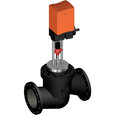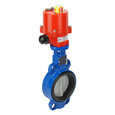Central Heating
Figure 1: Central heating system in a building basement
Central heating is a system that heats an entire building from one central location, providing consistent warmth throughout. These systems distribute heat through various means, such as hot water or forced air, to designated spaces within the structure. This article discusses the working of a central heating system, its key components, and how zoning improves energy efficiency.
Table of contents
- What is central heating and how does it work?
- Central heating system types
- Adding zones to a heating system
- FAQs
View our online selection of HVAC valves!
What is central heating and how does it work?
Central heating offers a consistent temperature throughout a building. The system is composed of three main elements: a heat source, a distribution system, and a control system. These systems utilize fuel—such as gas, oil, or electricity—in a boiler, furnace, or heat pump (discussed later) to generate warm air or water. The produced heat is then conveyed throughout the building via ducts and vents for furnaces or heat pumps, or through pipes leading to radiators or baseboard heaters in boiler systems.
Temperature regulation within the building is managed by a thermostat, which could be programmable or WiFi-enabled. Users set their preferred temperature, and the heating system cycles to maintain this setting.
Key components of a central heating system include:
- Burner: The burner ignites the fuel—gas, electricity, or oil—in the furnace or boiler to produce heat.
- Combustion chamber: Here, the burner ignites the fuel, mixing it with air to start the combustion process, ensuring efficient and safe operation.
- Heat exchanger: Post combustion, the heat exchanger captures the generated heat, transferring it through metal tubes, coils, fins, or plates.
- Blower: In forced air systems, the blower propels the warm air through the ductwork to vents around the house.
- Refrigerant: Essential in heat pumps, the refrigerant extracts heat from outside and brings it indoors, changing from liquid to gas and vice versa during the process.
- Ductwork: A network of ducts distributes the warm air from the furnace or heat pump throughout the building.
- Thermostat: Serving as the system's control center, the thermostat monitors the building's temperature and communicates with the heating system to adjust as needed based on user settings.
Central heating system types
Furnace
A furnace operates on the principle of forced air heating, utilizing air to disseminate heat. It combusts a fuel source—natural gas, oil, or propane—to warm the air. A blower fan then propels this heated air through ductwork, distributing it throughout the building through vents or air registers. The indoor temperature is regulated by a thermostat, which directs the furnace to turn on or off to sustain the set comfort level.
Boilers
Hydronic systems, commonly known as boiler-based systems, function by heating water within a central boiler, creating steam or hot water. This heated medium is circulated through pipes to radiators or baseboard units located throughout the building. As the water or steam releases its heat to the radiators, it effectively warms the surrounding air, thereby heating the space.
Figure 2: Boiler and pipes of a residential heating system
Heat pump
Heat pumps are a versatile option for areas with moderate climates, offering both heating and cooling capabilities. They operate by harnessing a refrigerant to absorb external heat and transport it indoors, where it is released to warm the space. The warm air is then distributed inside through vents and ductwork. In warmer months, the heat pump can reverse the refrigerant flow, functioning as an air conditioner by removing indoor heat and expelling it outdoors, thereby cooling the interior.
Figure 3: Heat pump
Table 1: Comparison of various central heating system types
| Heating system | Advantages | Disadvantages |
| Furnace |
|
|
| Boilers |
|
|
| Heat pump |
|
|
Adding zones to a heating system
One common issue with central heating is the unnecessary heating of unoccupied rooms, which leads to wasted energy and higher utility bills. Additionally, the one-temperature-fits-all approach may not account for the varying insulation levels and sun exposure in different areas of the building, resulting in uneven heating and discomfort.
Zoning in central heating systems addresses these inefficiencies by dividing the building into separate areas, each with its own thermostat. Here's how zoning can enhance the efficiency of a central heating system:
- Targeted heating: By creating zones, heating can be directed to where it's needed most, reducing energy consumption in seldom-used spaces.
- Individual comfort: Zoning allows for personalized temperature settings in different rooms, catering to the specific preferences of occupants.
- Reduced energy waste: By avoiding the heating of unoccupied or less-used areas, zoning significantly cuts down on energy waste.
- Improved system longevity: When a system operates more efficiently, it undergoes less wear and tear, potentially extending the lifespan of the heating equipment.
The integration of smart technology into central heating systems has revolutionized how they are controlled and monitored. Smart thermostats allow users to adjust heating settings remotely via smartphones or other devices, providing convenience and potential energy savings. These systems can learn user preferences and adjust automatically, contributing to a more efficient heating experience.
Figure 4: A building with two zones (A and B) for its heating system.
FAQs
What types of fuel can central heating systems use?
Central heating systems can use gas, oil, electricity, or renewable sources like solar power and biomass.
What is a zone valve in a boiler?
A zone valve controls the flow of water or steam in a heating or cooling system to maintain different temperatures in different zones.











